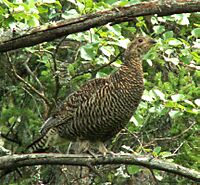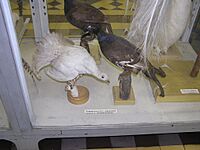Black grouse facts for kids
Quick facts for kids Black grouse |
|
|---|---|
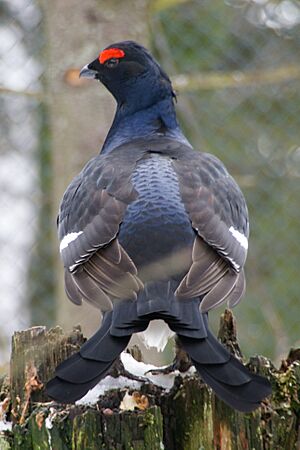 |
|
| Male |
|
| Conservation status | |
| Scientific classification | |
| Genus: |
Lyrurus
|
| Species: |
tetrix
|
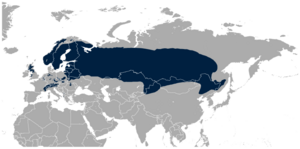 |
|
| Black grouse range | |
 |
|
| Distribution in Europe. | |
| Synonyms | |
|
|
The black grouse (Lyrurus tetrix) is a large bird from the grouse family. People sometimes call it the northern black grouse or blackcock. These birds usually stay in one place and do not migrate.
You can find black grouse across parts of Europe and Asia. They like to live in open, grassy areas like moorlands and steppes, often near forests. In winter, they stay in thick forests and mostly eat pine needles.
The female black grouse is greyish-brown. She makes a cackling or warbling sound. Like many birds in her family, she builds the nest and takes care of the chicks all by herself.
Contents
What is a Black Grouse?
The black grouse was first officially described in 1758 by a Swedish scientist named Carl Linnaeus. He gave it the scientific name Tetrao tetrix. Both parts of this name come from old Greek words for a type of game bird. Today, the black grouse is part of the Lyrurus group of birds.
Male black grouse are often called blackcocks. Females are called greyhens. These names have been used for a long time.
Different Types of Black Grouse
There are six different types, or subspecies, of black grouse. They look a little different in size and color. Birds found further east tend to be larger.
- L. t. baikalensis lives in southeastern Siberia and parts of Mongolia and China.
- L. t. britannicus is found in Scotland, Wales, and northern England.
- L. t. mongolicus lives in eastern Kyrgyzstan and parts of China, Kazakhstan, Siberia, and Mongolia.
- L. t. tetrix is found from Scandinavia to southern France and northern Italy, and northeastern Siberia.
- L. t. ussuriensis lives in eastern Siberia and northeastern China, including northwest Korea.
- L. t. viridanus is found in southeastern Russia to southwestern Siberia.
How Do Black Grouse Look?
Black grouse are quite big birds. Males are about 60 centimetres (24 in) long and weigh around 1,100–1,250 grams (2.43–2.76 lb). Females are smaller, about 45 cm (18 in) long and weigh 750–1,100 grams (1.65–2.43 lb).
The male black grouse is very striking. He has mostly black feathers with shiny blue colors on his neck and back. He also has white stripes on his wings and white feathers under his tail. Above each eye, he has bright red skin.
The female is much plainer. Her feathers are duller, helping her blend in with the plants. This helps her hide, especially when she is nesting. Both male and female black grouse have long outer tail feathers that curl outwards. These feathers look a bit like a Greek lyre, which is why their group name is Lyrurus.
Where Do Black Grouse Live?
Black grouse live in open areas across Europe and Asia. In Europe, you can find them from Great Britain and Scandinavia all the way to Russia. They also live in countries like Hungary, Poland, and Ukraine. There are some populations in the Alps mountains. Sadly, they are no longer found in Ireland or Denmark.
In Asia, many black grouse live in southern Siberia. They also live in parts of Kazakhstan, Mongolia, and China.
These birds like places where forests meet open areas. This includes steppes, heathlands, and grasslands. In winter, they gather in large groups in thick forests. They eat leaves and buds from trees like Scots pine and silver birch. In spring and summer, they prefer open spaces to find mates and raise their young. Their diet changes to berries and shoots from plants like cranberries. They avoid very hot deserts and very cold polar regions.
How Are Black Grouse Protected?
Even though the number of black grouse has gone down in western Europe, they are not considered globally endangered. This is because there are still many of them worldwide (about 15–40 million birds).
However, their numbers are decreasing in some areas. This is due to:
- Loss of habitat: Their homes are being destroyed.
- Disturbance: People or activities bother them.
- Predators: Animals like foxes and crows hunt them.
- Small populations: Very small groups of birds can die out easily.
Organizations like the IUCN have created plans to help black grouse. In the United Kingdom, black grouse live in the hills of Wales, the Pennines, and most of Scotland. They are often seen on farmland and moorland near forests.
Sadly, black grouse have disappeared from many places in England. For example, they are no longer found in Lancashire or Dartmoor.
A special project started in 2003 to bring black grouse back to the Peak District in England. They released birds there in 2003, 2004, and 2005. Groups like the National Trust and RSPB are helping with this effort.
In France, people are working to prevent black grouse from flying into ski-lifts. In China, black grouse numbers have also dropped due to habitat loss and too much hunting.
How Do Black Grouse Have Babies?
Black grouse have a very special way of finding mates. Every spring morning, male grouse gather in an open area called a lek. They compete to attract females. They fan out their fancy lyre-shaped tails and puff up their necks to show off. They also make a bubbling, cooing sound. Female grouse visit the lek to choose the healthiest male to mate with.
After mating, the female flies away to find a good nesting spot. She usually builds her nest on the ground, hidden in thick plants. It might be at the base of a tree, under branches, or next to a rock. She scrapes a small dent in the dirt and lines it with grass, sticks, leaves, and feathers.
She lays about 6 to 11 pale, speckled brown eggs. She sits on the eggs for about 23–28 days until they hatch. The baby chicks first eat insects. As they grow, they start eating more plants. When they are about 10–14 days old, they can already fly short distances!
Sometimes, black grouse can even have babies with other types of grouse or pheasants if their living areas overlap.
Black Grouse and People
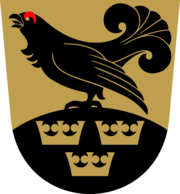
Since the late 1800s, the tails of male black grouse have been used to decorate hats. These hats are often worn with traditional Scottish clothing, like the Glengarry cap. Pipers in bands still wear them today. Some Scottish army regiments also wear black grouse tails on their hats as part of their uniform.
Gallery






